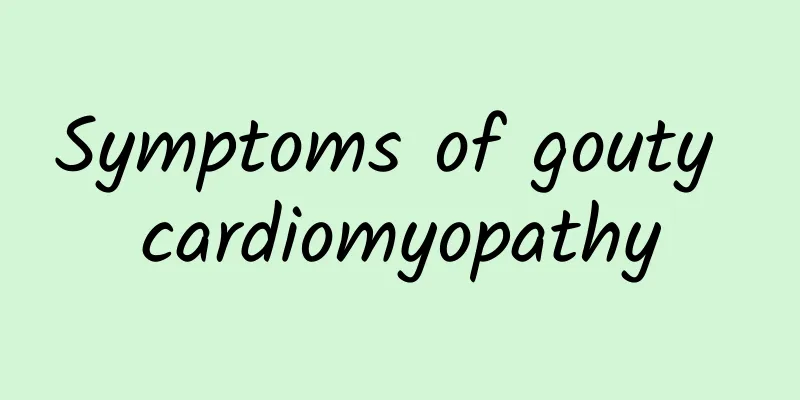Symptoms of gouty cardiomyopathy

|
Gouty cardiomyopathy is also a type of gout, and different symptoms indicate different types of diseases. However, no matter what type of disease it is, it will affect the patient's normal living habits. From this point we can see that timely detection of the disease and correct treatment will restore the patient to a healthy physical condition. If you want to treat it, you first need to understand the symptoms caused by these diseases so that you can distinguish what type of disease it is. Different diseases not only have different causes, the biggest difference is the symptoms they manifest, because symptoms are the only way for us to diagnose what kind of disease we have. Only by clearly knowing what type of disease the patient suffers from can we treat these diseases in a targeted manner. So what are the symptoms of gouty cardiomyopathy? Gout is a "crystal disease" in which urate accumulates and forms crystals in the body due to long-term disorders in purine metabolism. In very few cases, heart disease in gout patients is gouty heart disease caused by urate accumulation, crystallization, or even stone formation in the heart. Instead, it is more common because gout is easily combined with coronary atherosclerosis and hypertension, which leads to heart disease. Clinical manifestations 1. Gouty cardiomyopathy, cardiac gouty stones As a part of the body, the heart may occasionally accumulate urate, which may crystallize and even form nodules and growths that damage the heart structure and cause heart disease. 2. Coronary atherosclerotic heart disease Gout patients are susceptible to coronary atherosclerosis. Clinically, obesity, hypertension, diabetes, coronary heart disease, and gout are common in the same patient. Many scholars have pointed out that about half of gout patients suffer from hypertension. As a risk factor for coronary heart disease, hypertension can increase the pressure load on the left ventricle and promote left ventricular hypertrophy to form hypertensive heart disease. In recent years, some scholars have pointed out that hypertension can stimulate myocardial hypertrophy and hyperplasia. Because gout patients have joint involvement, most of them have insufficient activity, and about half of them become obese. In addition, 21% to 83% of gout patients have hyperlipidemia, and 21% to 73% have impaired glucose tolerance. Bluhm reported that the surface activity of platelets is increased, and those in a hypercoagulable state account for 51% of gout patients. The symptoms of gouty cardiomyopathy are introduced above. It turns out that patients with gouty cardiomyopathy may develop gout stones in the heart, and some patients may also develop coronary atherosclerosis. Therefore, only by clearly knowing the symptoms of the disease can we better research methods to treat these diseases, so that patients can improve their condition.
|
>>: How to treat acute laryngitis
Recommend
What causes thigh numbness? What are the causes?
I believe everyone has this experience in daily l...
Symptoms of a calf ligament strain
Leg injuries are common problems that people enco...
Chinese medicine fumigation treatment for hemorrhoids, the first choice for pregnant women with hemorrhoids
Women are also very likely to get hemorrhoids aft...
How long can you live with dementia?
Dementia means that the patient's brain begin...
What are the effects and functions of yellow cedar wood?
In many families, some furniture is made of pure ...
What to do if you feel dizzy after a stroke
The symptoms of cerebral infarction vary dependin...
Can I wear a mask after mole removal?
After having a mole removed, many people choose t...
How to prevent and treat pelvic effusion? Are you doing it right?
Pelvic effusion is a common gynecological disease...
How to improve shallow sleep and easy awakening
When you sleep, if you have a shallow sleep, you ...
Be careful not to damage your kidneys by using Chinese medicine like this
Because Western medicine can have side effects, m...
What are the treatments and dangers of the sequelae of neonatal encephalitis?
Japanese encephalitis, a sequela of encephalitis,...
Traditional Chinese medicine treatment of breast fibroadenoma, Chinese medicine treatment as a reference
Breast fibroadenoma is a benign tumor that can ca...
Why do you need to take medicine to remove dampness? Just drink a cup of tea every day and all the dampness will be gone in half a month.
The most obvious experience of heavy dampness in ...
What are the main components of miasma?
The greatest harm of miasma to the human body is ...
Neurofibromatosis
You may not have heard of this disease because it...









